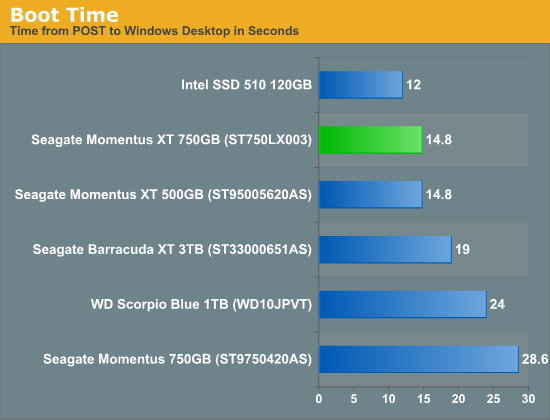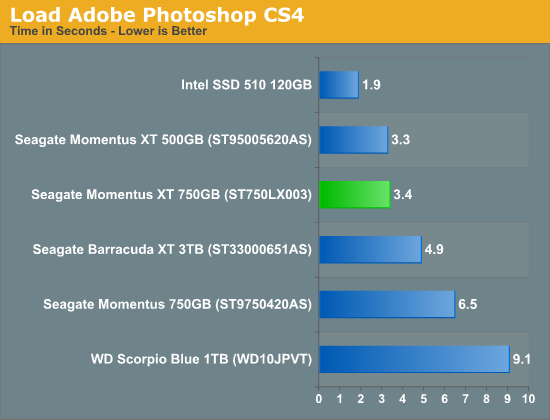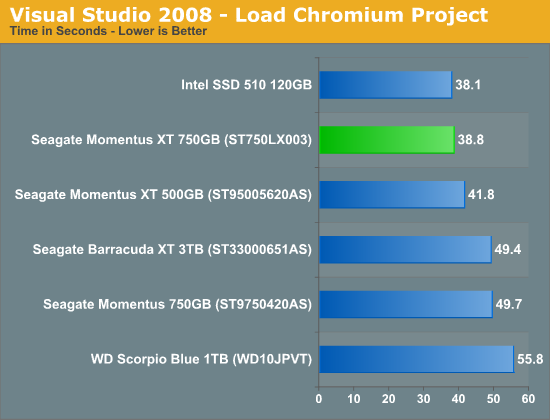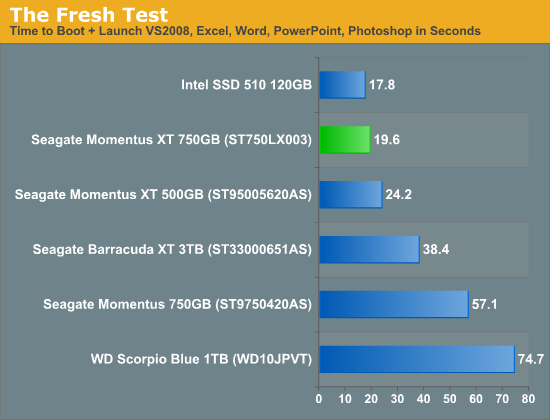Seagate 2nd Generation Momentus XT (750GB) Hybrid HDD Review
by Anand Lal Shimpi on December 13, 2011 12:51 AM EST- Posted in
- Storage
- Seagate
- Momentus XT
- Hybrid Drive
- HDDs
- SSHDs
Once More, With Feeling
Just as we did in our original Momentus XT review, we'll start with a look at some hand-timed application tests.
First up is a good old fashioned boot test. I measured boot time on our testbed from POST to first seeing the mouse cursor on the Windows 7 desktop. This isn't a timing of actual boot-to-use since more loading happens even after you get to the desktop, but it does encapsulate much of the Windows 7 boot process.
All tests were repeated until performance leveled off. In the case of an SSD, this was after just one run. In the case of the 500GB Momentus XT, it took five runs to get there, whereas the second generation model was there after just two. The traditional hard drives each took a few runs for their performance to stabilize as well due to Windows 7's own boot optimizations taking effect.

Boot performance continues to be very impressive on the Momentus XT. It's still not quite as fast as a high end SSD, but it's definitely faster than a traditional hard drive (even a faster, 3.5" model). With a larger NAND cache, your boot time is more likely to remain this low even as other applications and data are pulled into the cache.
Next let's look at a simple application launch test. Adobe Photoshop continues to be one of the more stressful workloads for a hard drive, even down to launching the application. Here I measured from the time I clicked on the Photoshop icon in the Start Menu to first appearance of the blank Photoshop canvas and toolbars. Again, I repeated this test until performance leveled off in all cases.
For the Momentus XT performance fluctuated and it never truly settled on a single launch time. Performance started out at over 5.6 seconds but for all runs after the 2nd launch time ranged in the upper 2s - upper 3s. For its results as well as those from all of the hard drives, I averaged five launch times and presented those averages. The lone SSD in this comparison delivered consistent performance across all runs.

Here the Momentus XT continues to do very well, for a hard drive. It's faster than any of our mechanical drives, and significantly faster than your run-of-the-mill 5400RPM 2.5" drive for sure. A good SSD is still around 70% faster than the Momentus XT.
When constructing our Visual Studio 2008 project build benchmark for our CPU reviews I was reminded just how much of a pain it is to do development work on a system with a hard drive. I tried using the same benchmark to measure drive performance however it seems I used too good of a CPU benchmark as disk performance plays a small role in actual compile time here. Instead I looked at the impact of disk performance on loading the Chromium project in VS2008. I used the same test rules as before, presenting performance once it has leveled off for all drives involved. Once again, the SSD delivered peak performance after a single run. The Momentus XT was able to do it after 2 - 3 runs. Performance didn't improve over multiple runs with the traditional hard drives.

There's a clear division between the NAND equipped Momentus XTs and the traditional hard drives here, but not so much between the former and the Intel SSD 510. I can definitely understand Seagate's temptation to draw the comparison to the performance of an SSD. The problem with doing this is highlighted in my comments above however. While the SSD always performed to the best of its abilities in our tests, regardless of the number of times I ran a test, the Momentus XT needed a couple of runs to get to that point. The NAND cache isn't overly predictive and as a result the first time you do almost anything the Momentus XT will perform like a traditional 7200RPM 2.5" hard drive. Given a light enough workload, the Momentus XT should be able to eventually fit much of the most frequently read data into its cache, but the process of actually getting there can still be painful.
For our last application level benchmark I turn to something I've used since the early days of SSD reviews: the fresh test. Take our boot test from earlier, and string together a series of application launches after you hit the desktop. In this case I'm launching Excel 2007, PowerPoint 2007, Word 2007, Visual Studio 2008 and Photoshop CS4 as soon as the system boots. I measure the time from POST until the last application is completely launched. I call this the fresh test because when you first build a machine everything, even on a traditional hard drive, performs quickly. Load up a lot of applications and use your system for a while and you'll soon notice that things aren't quite as snappy any more. Defragmenting your drive can help but after a certain point it's the bloat of everything installed that really limits performance. A better test would be to use an image that was months (if not years) old, but I've found that this benchmark gets the job done. Lower numbers here translate very well to a snappier system and one that feels new regardless of what you've got loaded on it. SSDs truly excel in the fresh test, but what about the Momentus XT?

Surprisingly enough, the Momentus XT does extremely well. The newer model clearly does a better job of keeping more data in NAND, but both are head and shoulders above the traditional hard drives. If you have a fairly regular usage pattern (E.g. you always run the same 5 or 6 applications), the Momentus XT can significantly improve the overall user experience. In some cases, it can even approach the performance of an SSD.










98 Comments
View All Comments
alan101 - Tuesday, February 28, 2012 - link
I've tried Seagate support by they can't seem to understand the question. Perhaps one of you fellow geeks can help?I want to buy the Momentus XT and then run OS X with FDE (FileVault 2). I'm curious whether the Momentus XT will still give me a better speed. My understanding is that the drive's firmware optimises by, for example, ignoring AVI files. With FDE, the firmware will not be able to detect whether a file is AVI or not. Will this noticeably affect the firmware's ability to optimise the use of the NAND cache?
Has anyone tested the performance with FDE? Results?
Rick999 - Sunday, March 4, 2012 - link
Good article by the way. I have read several analysis of the Momentus XT 750GB (and the 500GB - whose firmware was originally frought with bugs) and am now seriously looking at buying one of these, especially as you indicate that future firmware will cache writes (yes, put my swap/page files on that SSD). What I have not heard discussed is whether Windows Defrag (which will change LBA for portions of files) will impact the SSD Cache, especially if Seagates optimizing algorithms are looking at LBA to determine what is being repeatedly used. I.e., will a Defrag basically cause the read cache to need to be refreshed? Also, what impacts will certain applications that scan the entire disk have on the cache (like antivirus scans, search indexes, defrag, disk cleaner, chkdsk, backup, etc.). I.e. just because several of these different scans would seem to tell the drive that it sees file A read multiple times (for example, in a single weekend: antivirus, search index, defrag, backup - all reading file A - and EVERY other file too), so cache it, then file B is read multiple times too so cache it, file c, etc. You get the idea. Could these actions make the cache essentially overwrite itself constantly? Curious on your thoughts...djfourmoney - Tuesday, April 10, 2012 - link
I've been looking at RAID 0 for the laptop, but then I have a server. So do I really need 1.5TB or more like 1.2TB of space in my HTPC when I already have 1.3TB locally and 4TB in the server????I don't think I need a large hybrid drive and I consider myself a technician (A+) and an enthusiast though I am not much of a PC Gamer and a mild console gamer (don't even have a PS3 yet).
I guess for all the games I want to run on Rom Collector, that might make sense. But all SNES and NES games total are not very big (about 3GB) this would seem meaningless.
For consumers that use a laptop (and a cheap one, sub $500) for daily use/main use, this is a good compromise between the speed of SSD and the storage capacity @GB per $1 ratio spinning drive.
It would cost about $120-$150 for 2 SSD's (60-64GB) to run in RAID 0. Now why would you do that? Because a SATA III 120GB SSD say a Samsung is $175. The truth is, I only need 64GB for the HTPC. I will think about RAID 0 to take advantage of speed, but that increases my build budget and frankly I would put a 120-128GB in the Laptop and large drives (when prices come back down) in the server.
stdg20 - Saturday, May 5, 2012 - link
Hi Anand, How would the momentus xt 750gb compare to two 7200rpm hdds n RAID 0 configuration. And also what effect would putting a RAID 0 configuration of either 2 momentus xts or 2 7200rpm drives have on a laptops battery life. Thanks :)FloydT3 - Saturday, June 16, 2012 - link
I have never set up or used a RAID configuration on my PC and am wondering if the Momentus XT 750 would be a good choice?If so, I would like to set up and use the redundant configuration. The one where if a drive fails, no information is lost. Any tips or articles you can suggest for me to read on how to do this would be greatly appreciated.
Thanx
Floyd
jb510 - Friday, July 13, 2012 - link
I loved the Momentus XT line as a value/performance combination while SSD's were just too expensive at large capacity. I suffered through beachballs and stalls with my 500GB Momentus XT while waiting for firmware upgrades (which did finally resolve it) because when it worked it was much faster than a standard HDD... However...I figured the 2nd gen would be more reliable so I bought one right away... 2 months later it developed an inordinate number of bad blocks, going from SMART warning to SMART Failure in a couple more weeks. Seagate warranty replaced it only charging me for advanced replacement shipping. 2nd drive same problem 1 month later... repeat... The Seagate tech support rep I talked to when the 2nd drive failed didn't seem surprised and was actually confused because he said these drives were "known not to work with Mac's", however upon further checking he said that was the 1st gen drives but the 2nd gen were supposed to work fine. Trustingly I ordered a 3rd drive. Dead 1 month later....
I give up, SSDs have come down to what I consider reasonable prices (<$1/GB). Before all this I was of the mindset that the major brands had about equal failure rates and support... Now I'm I'm thinking Seagate isn't what it once was and am doublely disappointed that Samsung is now part of Seagate.
tipoo - Saturday, December 15, 2012 - link
2012 is all but over, Seagate support gave me some useless response about where to find the latest firmware when I asked them, and I couldn't join the Seagate forums due to some bugs in their software. So where is the write caching firmware update?The latest firmware is still the one the 750 originally shipped with.
danwat1234 - Sunday, October 11, 2015 - link
I share your pain, I'd love to see new firmware for this 750GB 7200RPM hybrid drive. And for Seagate to release a new one that's 2TB and 32GB of cache or so. But who knows how long it'll be before they get there.